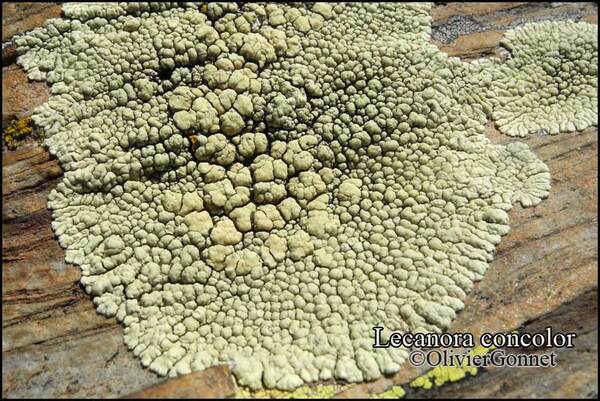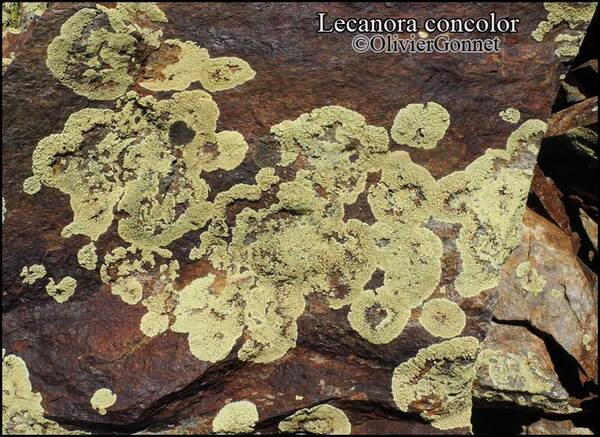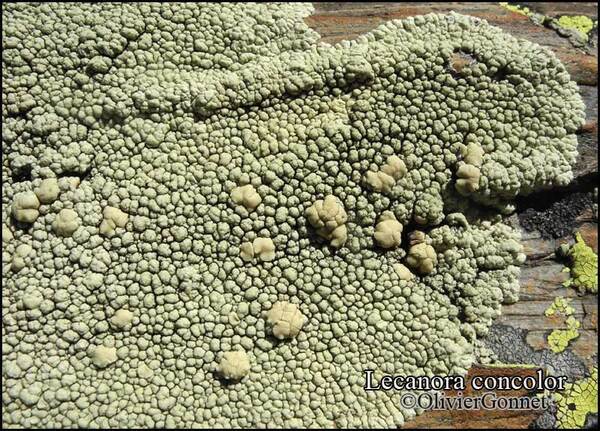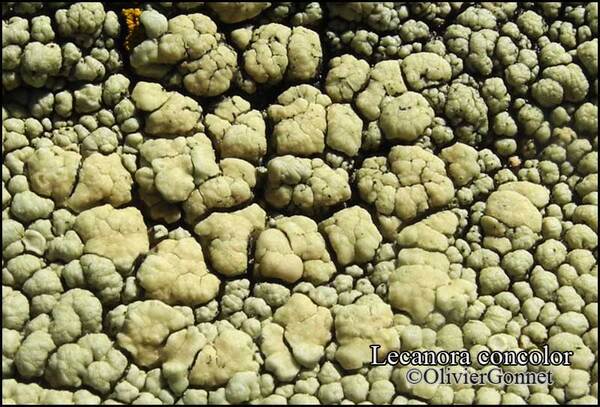Lecanora concolor Ramond
Mém. Soc. Linn. Paris, 4: 436, 1823.
Synonyms: Placodium concolor (Ramond) Körb.; Squamaria concolor (Ramond) Nyl.
Distribution: N - TAA (Nascimbene & al. 2022), Lomb, Piem (Isocrono & al. 2003, 2004), VA (Piervittori & al. 1998, Piervittori & Isocrono 1999, Piervittori & al. 2001).
Description: Thallus crustose-placodioid, episubstratic, firmly attached, rimose-areolate in the centre, lobed at margins, straw-yellow to yellowish green, forming rosettes 1-6 cm in diam. Central parts of thallus consisting of flat to bullate, c. 1 mm wide areoles; marginal lobes narrow, contiguous, flat to slightly convex, 2(-3) mm long, up to 1.2(-2) mm wide. Cortex c. 30 µm thick; medulla rather loose, inspersed with granules. Apothecia lecanorine, 1-3(-5) mm across, dispersed or clustered in small groups, with a greenish to brownish green, flat to convex disc, and a persistent, smooth to crenulate thalline margin. Epithecium poorly delimited, yellowish brown; hymenium 60-70 µm high, with yellowish granules; hypothecium colourless. Asci 8-spored, clavate, very thin-walled, with a K/I+ blue, tall tholus penetrated by a faintly amyloid apical cushion, the wall K/I-, surrounded by a blue outer layer, Lecanora-type. Ascospores 1-celled, hyaline, ellipsoid, 8-13.5 x 5-8 µm. Photobiont chlorococcoid. Spot tests: thallus K- or K+ indistinctly brownish yellow, C-, KC+ pale yellow, P-. Chemistry: thallus with usnic, rangiformic and norrangiformic acids.Note: on vertical to rain-sheltered surfaces of hard siliceous rocks, with optimum above treeline; certainly widespread throughout the Alps, where it reaches the nival belt. An earlier record from Marche (see Nimis 1993: 347), being dubious, is not accepted here.
Growth form: Crustose placodiomorph
Substrata: rocks
Photobiont: green algae other than Trentepohlia
Reproductive strategy: mainly sexual
In underhangs rarely wetted by rain
Commonnes-rarity: (info)
Alpine belt: rather rare
Subalpine belt: absent
Oromediterranean belt: very rare
Montane belt: absent
Submediterranean belt: absent
Padanian area: absent
Humid submediterranean belt: absent
Humid mediterranean belt: absent
Dry mediterranean belt: absent

Predictive model
Herbarium samples

Courtesy Danièle et Olivier Gonnet - Source: https://www.afl-lichenologie.fr/Photos_AFL/Photos_AFL_L/Texte_L_3/Lecanora_concolor.htm
France, Haut-Asco - Corse
5/10/2010


P.L. Nimis; Owner: Department of Life Sciences, University of Trieste
Herbarium: TSB (34522)
2002/01/18


P.L. Nimis; Owner: Department of Life Sciences, University of Trieste
Herbarium: TSB (35211)
2002/07/09

Courtesy Danièle et Olivier Gonnet - Source: https://www.afl-lichenologie.fr/Photos_AFL/Photos_AFL_L/Texte_L_3/Lecanora_concolor.htm
France, Haut-Asco - Corse
5/10/2010

Courtesy Danièle et Olivier Gonnet - Source: https://www.afl-lichenologie.fr/Photos_AFL/Photos_AFL_L/Texte_L_3/Lecanora_concolor.htm
France, Haut-Asco - Corse
5/10/2010
Growth form: Crustose placodiomorph
Substrata: rocks
Photobiont: green algae other than Trentepohlia
Reproductive strategy: mainly sexual
In underhangs rarely wetted by rain
Commonnes-rarity: (info)
Alpine belt: rather rare
Subalpine belt: absent
Oromediterranean belt: very rare
Montane belt: absent
Submediterranean belt: absent
Padanian area: absent
Humid submediterranean belt: absent
Humid mediterranean belt: absent
Dry mediterranean belt: absent

Predictive model
| Herbarium samples |

Courtesy Danièle et Olivier Gonnet - Source: https://www.afl-lichenologie.fr/Photos_AFL/Photos_AFL_L/Texte_L_3/Lecanora_concolor.htm
France, Haut-Asco - Corse
5/10/2010


P.L. Nimis; Owner: Department of Life Sciences, University of Trieste
Herbarium: TSB (34522)
2002/01/18


P.L. Nimis; Owner: Department of Life Sciences, University of Trieste
Herbarium: TSB (35211)
2002/07/09

Courtesy Danièle et Olivier Gonnet - Source: https://www.afl-lichenologie.fr/Photos_AFL/Photos_AFL_L/Texte_L_3/Lecanora_concolor.htm
France, Haut-Asco - Corse
5/10/2010

 Index Fungorum
Index Fungorum
 GBIF
GBIF






